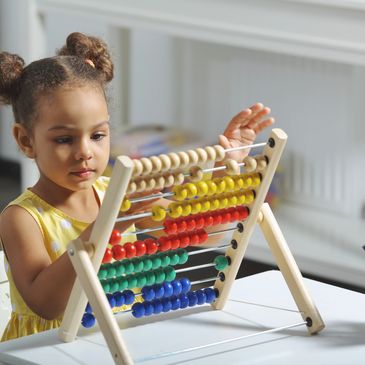Heggerty: Phonological Awareness Program

Our 2-year-old classroom provides students with their first formal exposure to all academic areas using hands-on and play-based learning.
The 4-year-old classroom is provided with tools and teaching strategies intended to ensure Kindergarten readiness. Reading Literacy, Math Literacy, Science, the Arts, and the development of both Fine and Gross Motor skills are paramount to this group's development.
The 3-year-old classroom provides students with a more intentional approach to academic success using whole and small group learning opportunities that enhance creativity through hands-on learning experiences.

The 3-year-old classroom provides students with a more intentional approach to academic success using whole and small group learning opportunities that enhance creativity through hands-on learning experiences.
The 4-year-old classroom is provided with tools and teaching strategies intended to ensure Kindergarten readiness. Reading Literacy, Math Literacy, Science, the Arts, and the development of both Fine and Gross Motor skills are paramount to this group's development.
The 3-year-old classroom provides students with a more intentional approach to academic success using whole and small group learning opportunities that enhance creativity through hands-on learning experiences.

The 4-year-old classroom is provided with tools and teaching strategies intended to ensure Kindergarten readiness. Reading Literacy, Math Literacy, Science, the Arts, and the development of both Fine and Gross Motor skills are paramount to this group's development.
The 4-year-old classroom is provided with tools and teaching strategies intended to ensure Kindergarten readiness. Reading Literacy, Math Literacy, Science, the Arts, and the development of both Fine and Gross Motor skills are paramount to this group's development.
The 4-year-old classroom is provided with tools and teaching strategies intended to ensure Kindergarten readiness. Reading Literacy, Math Literacy, Science, the Arts, and the development of both Fine and Gross Motor skills are paramount to this group's development.
Developmentally Appropriate Practices (DAP)
Research indicates that an effective teacher or family child care provider chooses a strategy to fit a particular situation. It’s essential to consider what the children already know and can do, as well as the learning goals for the specific situation. By remaining flexible and observant, we can determine which strategy is most effective, and if one approach doesn’t work, we can try another.
National Association for the Education of Young Children
NAEYC defines “developmentally appropriate practice” as methods that promote each child’s optimal development and learning through a strengths-based, play-based approach to joyful, engaged learning. Educators implement developmentally appropriate practices by recognizing the multiple assets that all young children bring to the early learning program, as unique individuals and as members of families and communities. Building on each child’s strengths—and taking care not to harm any aspect of their physical, cognitive, social, or emotional well-being—educators design and implement learning environments to help all children achieve their full potential across all domains of development and in all content areas. Developmentally appropriate practice recognizes and supports each individual as a valued member of the learning community. As a result, to be developmentally appropriate, practices must also be culturally, linguistically, and ability appropriate for each child.
Use this link to learn more:
Files coming soon.
This website uses cookies.
We use cookies to analyze website traffic and optimize your website experience. By accepting our use of cookies, your data will be aggregated with all other user data.